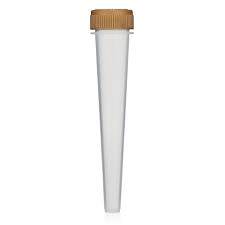
While Brigade Packaging‘s commitment to sustainability with their 100% biodegradable clear 116mm pop-top pre-roll tubes is commendable, a closer examination reveals several areas where the product may not entirely live up to expectations.
Eco-Friendliness:
The standout feature of these tubes is their biodegradable nature. Certified by the USDA, they showcase a strong commitment to reducing environmental impact. However, the very feature that makes them environmentally friendly also raises questions about their long-term usability and impact.
Durability:
The biodegradable nature of these tubes, while eco-friendly, implies a limited lifespan. This could be a significant drawback for products that require longer shelf stability. There’s also a concern about how well these tubes would hold up under varied environmental conditions, such as humidity or temperature fluctuations, which are common in storage and transport.
Safety and Health Compliance:
The child-resistant feature of these tubes meets essential safety regulations, which is a positive aspect. However, the clarity of the tubes, while providing product visibility, may compromise discretion. This could be a concern for businesses and consumers who prefer more privacy in their packaging choices, raising questions about the overall suitability of these tubes in certain markets.
Cost-Effectiveness:
Perhaps the most significant drawback of these tubes is their cost. Being on the higher end of the pricing spectrum compared to traditional plastic options, they may not be feasible for smaller businesses or those with tight budgets. The higher cost could be a significant barrier to widespread adoption, particularly in an industry where margins can often be tight.
Conclusion
In summary, while Brigade Packaging’s biodegradable joint tubes have admirable environmental credentials, they present challenges in terms of durability, discretion, and cost. These factors may limit their appeal to a specific segment of the market, particularly those willing to absorb the higher costs for the sake of environmental sustainability.
